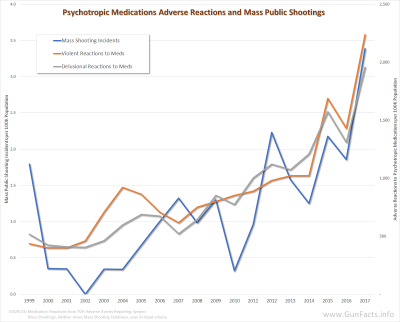Meds and Mass Murder
Is national consumption of brain candy contributory to mass public shootings? Looks like it might well be.
Takeaways
- There exists covariant rise in the per capita number of adverse psychological reactions to prescription psychotropic medications and mass public shootings.
- The rate of adverse medication reactions may be low by an order of magnitude.
Mental health and mass shootings
The Gun Facts project previously reported on the association between mental health and mass public shootings. However, the review omitted one interesting issue – the contribution of pharmaceutical psychotropic medications.
psychotropic: affecting mental activity, behavior, or perception
We first became concerned with this topic after the Columbine Massacre. It was reported that one of the two assassins did a cold turkey withdraw from Luvox (an antidepressant) because a known side effect was rage. In other words, he wanted to be as amped-up as possible to commit mass murder.
When we started looking for information back then, we quickly became aware that many (perhaps most) psychotropic medications presented adverse reactions both when the patient was taking the medications and when they withdrew from them. From our previous report on mental health, a troubling situation came to light:
- America had closed 2/3rds of their psychiatric beds
- They did so in part because of these new medications, thinking that patients would be self-maintaining outside of institutions
- Since patients are notoriously unreliable, there was likely an increase of at-large patients taking the wrong doses or quitting their medications in an uncontrolled manner
The Gun Facts project decided to see if medications might be an issue, and we found a viable pool of data to explore.
Manifestations of madness
VIOLENT REACTIONActivation Syndrome |
DELUSIONAL REACTIONAcute Psychosis |
Debriefing reports of mass public shooters who survived shows two main areas where their condition and medications might trigger mass violence:
- VIOLENT REACTIONS: Effects of medications that are violent or associated with violent acts
- DELUSIONAL REACTIONS: Effects where the patient disassociates from reality in a way that might trigger violent acts
We happened upon the federal Food and Drug Administration’s Adverse Events Reporting System (FAERS). This is the database into which medical professionals report observed negative reactions to medications. Within all the categories of reaction types was an entire “reaction group” called “psychiatric disorders.” We reviewed the elements within that group, isolated those that were “violent” or “delusional” and started digging for data.
Next, we combed the web and devised a list of the 35 most frequently prescribed psychotropic medications. These fell into several classes – antidepressants, mood stabilizers, and anti-psychotics. That last group is of particular interest because they are commonly prescribed for autism patients, and as noted in our previous mental health report, autism is the #1 mental impairment associated with mass murderers.
For both major groups, we used the FDA website to report the total combined number of adverse reactions (and according to one review 1, reports to the FDA are estimated to be only 10% of the actual number). We then calculated the per capita reactions and mass public shootings to see if there was any covariance.
We kinda saw this coming
 We suspected a covariance, but we were rather surprised at how tightly the curve fit.
We suspected a covariance, but we were rather surprised at how tightly the curve fit.
We looked at mass public shootings and medication data from 1999 through last year. We decided this was rational since we have some evidence that the 1999 Columbine Massacre encouraged copycat shootings. Evaluating data before 1999 would invite pre- and post-Columbine national mindsets, whereas everything post-1998 would not.
Aside from a drop in mass public shootings for a few years after Columbine, we see something close to a lockstep acceleration of both types of adverse reactions and mass public shootings. Granted, there are other variables and correlation does not mean causation. But the covariance does mean this topic has to be front-and-center in public discussions and academic research into these drugs.
For the “number nuts,” the R2 for both the delusional and violence reactions based against mass public shootings are above 0.7. If we include all years from 1999 through 2017, the R2 for delusional reactions is still 0.7, though violent reactions slip to 0.6.
Warnings and summary
First, a few grains of salt:
- RAW DATA: If the FDA’s assumptions about only 10% of adverse reaction being reported is true, we may have some source data inaccuracy. But given that over 13,000 adverse violence and delusion reactions were reported, odds are the raw data is more than sufficiently accurate.
- CAUSATION: We cannot assume that there is a causation just because there is correlation. But this shows the need for full disclosure of medical records of all mass public shooters. With such additional data, we can examine the core concern with greater accuracy.
- CONSUMPTION: Finding records on the number of people taking these medications has been fruitless (and if you do have a good source for such data, we want to hear from you). The analysis would be improved by adding consumption rates along with reaction rates.
- POPULATION STATS: The Census Bureau is amazingly frustrating. Mass shooting databases show the cutoff age for the assassins to be 15 years old. We wanted to use population stats for 15 years and older; but (a) this was not easily doable from the Census Bureau’s cluster &^%&*^ website, and (b) their “contact us” link autogenerated a “go away” response. Your tax dollars not at work.
Primarily, add this info to your talking points and if you have family members taking this stuff, watch your back.
Special thanks to the Gun Facts research volunteers who helped in the data gathering for this project.






